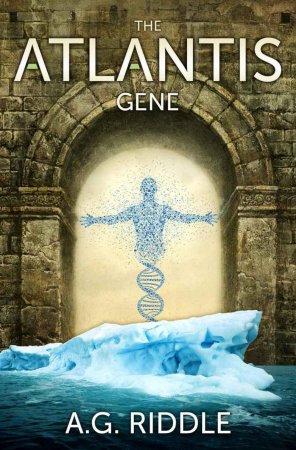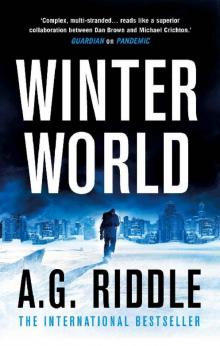- Home
- A. G. Riddle
The Extinction Files Box Set Page 8
The Extinction Files Box Set Read online
Page 8
She grabbed a blue marker from the whiteboard’s tray. “Okay, let’s get started. As you know from the preliminary briefing, we’ll be splitting up in Nairobi. Eleven of you will be assisting with operations there; the remainder will join me in Mandera and will likely travel to the surrounding areas. However, I want each of you to be versed on our PPE protocol for the deployment, and I want to share some basic background information. We’ll cover mission-specific directives once we get closer to landing.”
She quickly covered their PPE, which included gowns, coveralls, hoods, goggles, boot covers, gloves, and other items used to protect against infectious material.
“There’s a chance that each of you will come into contact with the pathogen in some way. Those of you in Nairobi may be called into the field. First, know that it will be hot inside the suits. Kenya is located in a tropical zone. Nairobi is just eighty-eight miles from the equator. Even though it’s November, the midday sun in Kenya will cook you. You’ll be sweating before you put your suit on, and you’ll sweat even more while wearing it.
“Second, you’ll likely be unnerved by what you see. Some of us never get used to the human suffering we encounter during these deployments. There’s nothing wrong with that. You’re going to witness people living in poverty and circumstances you may have never seen before. If you feel overwhelmed, it’s okay to excuse yourself. Just let a team member know, then walk away and take deep breaths. Whatever you do, do not take your suit off. Inspecting and donning your suit is important, but being careful while doffing it is even more important. After you’ve had contact with patients, you may have virus particles and bacteria on the outside of your suit, hood, goggles, gloves, and boots. If you just rip any part of your PPE off, you’re putting your life at risk. When it comes to removing your suit: take—your—time. It won’t be easy; one hour is about all anyone can stand in the suits in this kind of heat, and by the end of that hour, you’ll be dying to get free. But again, take your time. Your life depends on it.
“Okay, what’s our deployment goal here? Anybody?”
The EIS agents, most in their late twenties or early thirties, sat near the front. The permanent CDC staff on the mission were a bit older, and most had deployed for a dozen outbreaks before. They sat toward the back and kept quiet during the Q&A, giving the EIS officers the opportunity to answer and learn.
In the second row, a woman named Hannah Watson answered. Her strawberry-blond hair was tied in a ponytail, and like Peyton, she wore Commissioned Corps service khakis.
“Containment and treatment.”
“Good.” Peyton wrote the words in large block letters on the whiteboard. “What else?”
“Identification,” Millen Thomas called out. He was a veterinarian of Indian descent, sitting several rows behind Hannah.
Peyton nodded as she wrote the word on the board. “Yes, it would be nice, at some point, to know exactly what we’re dealing with here. What else?”
An EIS officer in plain clothes called out, “Capacity building.”
“Very good. We are here to identify, treat, and contain this disease, but we’re also here to help the Kenyans develop their own capacity to stop outbreaks. The CDC has poured millions of dollars into Kenya with the hope of developing a disease detection and surveillance system as well as native capability to respond to outbreaks.
“In the battle against pandemics,” Peyton continued, “we have only one hope, and that’s to stop outbreaks where they start. To do that, we need to enable the Kenyans. For those of us in the field, it means training the Kenyan field epidemiologists. In Nairobi, that means giving the staff in the Ministry of Health and their EOC the support and training they need.
“Okay.” Peyton turned back to the board and circled the word Identification. “How do we identify?”
“Lab tests,” a black-haired girl called out.
“Yes. We have a field test for Ebola: the ReEBOV Antigen Rapid Test Kit. ReEBOV will give us a result in about fifteen minutes. Accuracy is 92% for those infected and about 85% for those negative. What else?”
“Symptoms. Disease progression,” a black man in the front row said.
“Correct. If we can establish a consistent pattern of symptoms, we can make a pretty good guess about what we’re dealing with. We’ll be taking patient histories from multiple locations. In Nairobi, your job will be to take all those data points and establish a clear pattern. We’re looking for trends and commonalities. Now—assuming this is Ebola, what are the symptoms?”
Voices across the group called out:
“High fever.”
“Severe headache.”
“Diarrhea.”
“Vomiting.”
“Stomach pain.”
“Fatigue and weakness.”
“Bleeding.”
“Bruising.”
Peyton wrote quickly. “Good. The patients at Mandera presented with most of these symptoms. The physician there also reported seeing a rash. So we may or may not be dealing with Ebola. It may be a completely new filovirus or arenavirus. We know the disease we’re facing is deadly and that it has sickened people in what we believe are two different locations. It takes a human anywhere from two to twenty days to develop Ebola symptoms. On average, infected individuals develop symptoms eight to ten days after contact with the virus. All right. Again, if this is Ebola, how do we treat it?”
“We don’t,” said a white physician in the third row.
“ZMapp,” a redheaded girl said.
“You’re actually both right. There is no FDA-approved treatment for Ebola. There is no vaccine. If a patient breaks with the disease, we simply give them fluids, electrolytes, and treat any secondary infections. In short, the patient is on their own. The hope is that their immune system fights and defeats the virus. About half do; the average Ebola case fatality rate is fifty percent.
“It’s also important to note that there are five known strains of Ebola: Zaire, Ivory Coast, Sudan, Bundibugyo, and Reston. Reston ebolavirus is the only strain that’s airborne. It’s named Reston because it was discovered in Reston, Virginia, only miles from the White House. It is quite possibly the greatest piece of luck in human history that the Reston strain only causes disease in non-human primates. In fact, during the Reston outbreak—which occurred at a primate facility—several researchers were infected. Luckily, all remained asymptomatic. If Ebola Reston had been deadly for humans, there would be a whole lot fewer of us around today. The other four strains of Ebola are among the most deadly pathogens on the planet. Zaire ebolavirus is the worst, killing up to ninety percent of those it infects.
“ZMapp is the only therapy that has proven effective in treating Ebola. It did very well in primate trials. During the West African Ebola outbreak in 2014, we treated seven Americans with ZMapp and an RNA interference drug called TKM-Ebola. Unfortunately, two of those patients died, but five survivors out of seven is still beating the usual odds. We have some ZMapp with us in the cargo hold, but it’s a very small quantity, and I want to stress again that it is not FDA-approved and has had mixed results in humans.
“Can anybody tell me what type of therapy ZMapp is?”
A voice called out, “A monoclonal antibody.”
“Correct. ZMapp is a monoclonal antibody or mab. In fact, it has three mabs. They’re grown in tobacco plants, strangely enough, and they bind the Ebola protein as if they were antibodies made by the patient’s own immune system. So, how might that impact future treatments? Anybody?”
Peyton paused and looked around the group. When no one answered, she continued. “Survivors. Studying the antibodies that survivors produce could offer clues about new therapies and ways to fight the virus. So it’s incredibly important that we document those survivors. In fact, there’s research in progress right now that’s doing just that: studying the immune systems of people who survived a Marburg outbreak years ago. In a worst-case scenario, we could also try using convalescent blood or plasma from survivors to treat critical p
ersonnel in Kenya.
“Survivors could also offer clues that would help in the development of a vaccine. In fact, Merck already has trials underway for an Ebola vaccine. Thus far, it appears to be incredibly effective, but we don’t think it offers lifetime immunity. It hasn’t received regulatory approval yet, and it doesn’t protect against every strain of Ebola, so identification will be key here. Nevertheless, if this is Ebola, the Merck vaccine could get fast-track approval and end up saving a lot of lives in uninfected populations.
“Bonus question: can anyone name the other type of therapy in trials to treat Marburg and Ebola?”
Peyton scanned the group. When, once again, no response came, she said, “Small interfering RNA. Shows great promise, but it’s a long way from the market.
“All right, let’s discuss containment. What’s the key?”
“Contact tracing,” Hannah said.
“Exactly. Our goal is to find patient zero and build a tree of everyone they had contact with and everyone those people had contact with. It can be overwhelming. Some days you’ll go out and it’ll feel like the contact list is exploding—you’ll be adding hundreds of people each day. But have faith and keep working at it. Eventually the list will start shrinking—if we’re winning.
“Okay. What do we know about Ebola’s transmission?”
“It’s spread by bodily fluids,” said a physician in the second row.
“Good. What else?”
“It’s zoonotic,” Millen said.
“Yes. Very good. Ebola and other filoviruses are all zoonotic—they jump from animals to humans and back. Zoonotic infections are a huge issue in central Africa. In fact, seventy-five percent of all the emerging infectious diseases here are zoonotic in nature. We can’t just focus on human-to-human transmission to stop the spread.
“Now, raise your hand if you’re a veterinarian.”
Four hands went up. Three were Commissioned Corps members in tan khakis; the fourth wore civilian attire.
“Each of you will be assigned to one of the teams in the field doing contact tracing. What are you looking for?”
“Bats,” they all said in unison.
“Correct. And what are bats?”
“Mammals,” said one vet.
“Reservoir hosts,” said another.
“Correct on both counts. The natural reservoir host for Ebola remains unknown, but we’re almost certain that African fruit bats harbor the virus without symptoms. When it jumps from bats to humans, it wreaks havoc. So we’re looking for anyone who may have come into contact with bats or bat droppings. Maybe they went into a cave or ate bush meat that contained bat, or maybe they consumed another animal that came into contact with a fruit bat. It’s likely that when we find our index case, they’ll have contracted the virus from a bat.”
To the entire group, Peyton asked, “What do we do with people showing symptoms of the disease?”
“Isolation,” they said in unison.
“And people they’ve had contact with but who show no symptoms?”
“Quarantine.”
“That’s right. In this instance, the quarantine period is twenty-one days from the time they first had contact with the virus. If they are symptom-free after twenty-one days, we turn them loose.”
She looked over the assemblage. “Any questions?”
When no one spoke, she placed the dry-erase marker back in the whiteboard’s tray. “Good. Let’s split up into groups. We’ve still got a lot to do before we arrive.”
Chapter 12
In Berlin, Desmond was preparing for the next day’s meeting.
He had gone out just after sunset, when the streets were filled with people. Wearing the hat and secondhand clothes he’d purchased earlier in the day, he moved quickly, never making eye contact. At a drogerie, he bought the items he most desperately needed.
He stood now in the tiny, white-tiled wet room of the flat, watching his blond hair fall into the sink as the clippers buzzed. He left only about a quarter of an inch all over. He applied the dark hair dye and sat on the Murphy bed.
As he waited for the dye to soak in, he took out the disposable smartphone and did an internet search for himself—something he’d been wanting to do ever since he’d acquired the device.
The first hit was for a news article from Spiegel Online. The police had found the taxi driver. And more: American authorities had raided his home outside San Francisco. So he was an American—or at least had a home there.
The second search result was for Icarus Capital, where he was listed as the founder and managing partner. He quickly read his bio, but it was all about his career: investment successes, public speeches given, and a smattering of community commitments. He was a patron of the California Symphony, apparently. None of the organizations listed rang a bell.
He clicked the Investments page and read the names: Rapture Therapeutics, Phaethon Genetics, Rendition Games, Cedar Creek Entertainment, Rook Quantum Sciences, Extinction Parks, Labyrinth Reality, CityForge, and Charter Antarctica.
Rapture Therapeutics. He had seen that name earlier that morning—on the employee ID card from the dead man in his hotel room.
He navigated to the Rapture Therapeutics website.
It was a biotech company focused on neurological therapies. Rapture had initially focused on helping patients manage depression, schizophrenia, bipolar, and other psychological conditions. Their most recent offering, Rapture Transcend, targeted brain plaques and eliminated them using a genetically engineered protein.
Desmond wondered if their work could be connected to what had happened to him. His firm was an investor in Rapture Therapeutics. Had he discovered something they didn’t want him to know? Could he be part of a clinical trial gone bad?
He continued reading the Rapture website, intrigued by what he learned. The company seemed to be on the cusp of a major breakthrough. Two years ago, Rapture had licensed a therapy that might well hold the key to curing Parkinson’s, Alzheimer’s, Huntington’s, amyloid disorders, and a host of other neurodegenerative diseases.
The key to this potential cure was reportedly discovered by accident. In 2004, an Israeli researcher named Beka Solomon was conducting Alzheimer’s trials when she stumbled onto a new therapy that reduced the brain plaques associated with Alzheimer’s by an astounding eighty percent. That made it far more effective than any treatment on the market.
But Solomon had actually begun her trials with a focus on a completely different therapy. She had genetically engineered mice to develop Alzheimer’s and was treating the mice with a human-derived antibody, which she administered via their nasal passages. The problem was, her therapy didn’t effectively cross the blood-brain barrier and reach the plaques in the parts of the brain affected by Alzheimer’s. In what might go down as one of the greatest twists of scientific luck, Solomon decided to attach her antibody to a virus called M13 to transport it across the blood-brain barrier.
M13 was a special type of virus called a bacteriophage—a virus that infected only bacteria. And M13 infected only one type of bacteria: Escherichia coli, or E. coli. To Solomon’s surprise, the antibody, when attached to M13, showed great success in her trials. But what was truly surprising was that the group of mice treated with the M13 virus alone—without Solomon’s antibody therapy—also showed incredible improvement. It seemed that the positive outcomes from the trials were due entirely to M13, not to Solomon’s actual antibody therapy.
After a year of treatment, the mice that received M13 had, on average, less than a fourth of the plaques of those in the control group. Subsequent experiments showed that M13 could also dissolve other amyloid aggregates—the tau tangles found in Alzheimer’s and the amyloid plaques associated with other diseases, including alpha-synuclein (Parkinson’s), huntingtin (Huntington’s disease), and superoxide dismutase (amyotrophic lateral sclerosis). The M13 phage even worked against the amyloids in prion diseases, a class that included Creutzfeldt-Jakob disease. The discovery was startling an
d represented a potentially huge breakthrough in the fight against neurodegenerative diseases.
Thus began the long process of trying to figure out how M13 did its miraculous work. After years of research, scientists discovered it was actually a set of proteins—called GP3—on the tip of the M13 virus that was the key to its incredible ability. The GP3 proteins essentially enabled M13 to attach to E. coli and unzip the bacteria, allowing M13 to inject its own DNA inside for replication. And by a stroke of sheer luck, the GP3 proteins also unlocked clumps of misfolded proteins found in Alzheimer’s, Parkinson’s, Huntington’s, and other diseases.
Desmond turned this information over in his mind. He had no doubt that Rapture Therapeutics was a large part of the puzzle. It was, after all, their employee—Gunter Thorne—he’d found dead in his hotel room.
Maybe the answers would come tomorrow, at the meeting.
He closed the Rapture Therapeutics site and returned to the web search he’d done on himself. But the remaining links were of no help. He had no social media presence, and the other links were just articles about companies he was involved in or videos of him speaking at conferences or appearing in video interviews. His entire life seemed to be limited to his professional involvement in high-tech startups.
Next he did an internet search for Peyton Shaw. When he had called her that morning, she had known who he was. If he could find out who she was, and how she knew him, it might give him a clue to his own identity.
He learned that she was a leading field epidemiologist for the CDC. That was interesting. Was she somehow involved with Rapture Therapeutics? It seemed unlikely; her focus was infectious diseases.

 The Atlantis Gene: A Thriller
The Atlantis Gene: A Thriller The Solar War (The Long Winter Book 2)
The Solar War (The Long Winter Book 2) The Extinction Files Box Set
The Extinction Files Box Set The Atlantis Trilogy Box Set- The Complete Series
The Atlantis Trilogy Box Set- The Complete Series Winter World
Winter World Genome
Genome Pandemic (The Extinction Files Book 1)
Pandemic (The Extinction Files Book 1) The Atlantis Gene: A Thriller (The Origin Mystery, Book 1)
The Atlantis Gene: A Thriller (The Origin Mystery, Book 1) Departure
Departure Genome (The Extinction Files Book 2)
Genome (The Extinction Files Book 2) The Atlantis World (The Origin Mystery, Book 3)
The Atlantis World (The Origin Mystery, Book 3) The Atlantis Plague: A Thriller (The Origin Mystery, Book 2)
The Atlantis Plague: A Thriller (The Origin Mystery, Book 2)